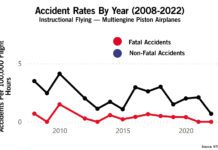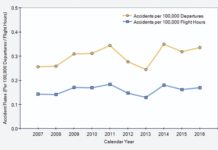May 1, 2014, Frederick, Md. Robinson Helicopter R22 Beta
The flight instructor and student were practicing hover operations, during which the helicopter drifted right and descended. The right skid contacted the grass, the helicopter rolled to the right and the main rotor blades contacted the ground. The helicopter came to rest on its right side. There was substantial damage. The pilots reported no pre-impact mechanical malfunctions or failures. This was the first flight in a helicopter for the student pilot.
May 2, 2014, New Braunfels, Texas Piper PA-24-250 Comanche 250
Prior to the outbound flight, the pilot estimated the airplane had 40-45 gallons of fuel on board, with a planned en route time of 57 minutes and about a 10-knot tailwind. Once at cruise, he set power for a fuel burn of 12.3 gph. For the return leg, he estimated 12-15 gallons in the left tank and 10 in the right, for a total of 22-25 gallons.
After departing for the return flight, he switched fuel tanks from the left side to the right side. About 15 minutes later, the pilot noticed a reduction in power and switched back to the left tank. Engine power was restored. A few minutes later, the engine lost power and the pilot performed a forced landing to a construction site. Examination revealed the fuel tanks were empty and were not breached in the accident.
May 2, 2014, Middlesboro, Ky. Beech V35B Bonanza
At about 1340 Eastern time, the airplane collided with terrain during a landing attempt. The private pilot sustained serious injuries and a dog sustained minor injuries. The airplane sustained substantial impact and thermal damage to both wings and fuselage. Visual conditions prevailed.
The pilot purchased the airplane the morning of the accident. Shortly after departure, on the accident flight, the pilot announced on CTAF that a “door popped open” and he was returning to land. An eyewitness stated that on final approach and at about 30 feet agl, the airplane banked to the left, rolled wings level, flew perpendicular away from the runway and impacted the ground in a flat attitude. The airplane subsequently became engulfed in flames and the pilot extricated himself from the airplane with thermal injuries.
May 3, 2014, Bluffdale, Utah Pitts Model 12 Experimental
The airplane was substantially damaged at about 2000 Mountain time in an off-airport landing. The pilot and his passenger received minor injuries. Visual conditions prevailed.
The pilot had recently purchased the airplane, which was equipped with a Vendenyev M14 series radial engine, and he and his wife were ferrying it home. The first leg was uneventful, after which the pilot topped off the fuel tank. On the second leg, while descending for a second fuel stop, the engine quit. The pilot switched tanks without success and then performed an off-airport landing in an open field, during which the airplane landed hard and “flipped over on its back.”
May 4, 2014, Advance, N.C. Czech Sport Aircraft SportCruiser
At about 0930 Eastern time, the airplane was involved in an off-airport landing in a pasture. The private pilot sustained serious injuries and the airplane was substantially damaged. Visual conditions prevailed.
Examination revealed the airplane initially impacted the ground approximately 45 feet from where it came to rest. About 12 gallons of fluid similar in color and smell to automotive gasoline was noted leaking from the airplane. Control continuity was established from the cockpit to the rudder, elevator and left aileron but could not be determined to the right aileron due to impact damage. The propeller did not display scoring or bending.
May 4, 2014, Fairfield, Calif. Boeing E75 (Stearman)
The airplane was destroyed at about 1359 Pacific time when it impacted the runway during an aerial demonstration flight and was involved in a post-crash fire. The solo commercial pilot received fatal injuries. Visual conditions prevailed. The pilot was one of several civilian aerial demonstration pilots who performed at a two-day air show at Travis Air Force Base. All his flights preceding the accident flight were uneventful.
The accident occurred during a “ribbon-cut maneuver.” The first two passes were to be conducted with the airplane upright, and were not planned to contact the ribbon. The final pass was to be conducted inverted, and the airplane would cut the ribbon with its vertical stabilizer. The first two passes were successful, but on the third (inverted, ribbon-cut) pass, the airplane was too high, and did not cut the ribbon. The pilot came around for a fourth pass, and rolled the airplane inverted after aligning with the runway. The airplane contacted the runway prior to reaching the ribbon, slid inverted between the ground crew personnel holding the poles, and came to a stop a few hundred feet beyond them.
Review of image and ground scar data indicated that the airplane first contacted the runway with its right wing, followed by the tail, the left wing and then the propeller. The airplane slid a total distance of about 740 feet. Fire became visible just before the airplane came to a stop, and the fire patterns were consistent with a pool of spilled fuel. Within about 50 seconds, the fire encompassed most of the right (downwind) side of the airplane. Firefighting vehicles and personnel arrived at the airplane three to four minutes after the accident, and extinguished the fire. An automated weather observation at 1358 included wind from 240 degrees at 15 knots gusting to 21, visibility 10 miles and few clouds at 18,000 feet.
May 6, 2014, Cody, Wyo. Mooney M20C
At about 1200 Mountain time, the airplane collided with mountainous terrain. The private pilot/owner and private pilot-rated passenger were presumed to have sustained fatal injuries. The airplane sustained substantial damage to the forward fuselage and both wings. Instrument conditions prevailed at the accident site.
Both occupants were brothers, and were touring the country to visit friends and relatives. Family members became concerned when they had not heard from the occupants. An alert notice was issued on May 10 and, using radar data provided by the Air Force Rescue Coordination Center, local search and rescue personnel were able to visually locate the airplane by helicopter. As of this writing and due to the inhospitable nature of the terrain, the accident site was inaccessible to NTSB or search and rescue personnel.
May 7, 2014, Covington, Tenn. Piper PA-28-181 Archer
The airplane was destroyed at 1107 Central time when it collided with wooded terrain during a forced landing following a total loss of engine power on approach. The solo private pilot was seriously injured. Visual conditions prevailed; an IFR flight plan had been filed.
Preliminary information revealed the airplane was at 6000 feet msl and eight miles northeast of its destination when the pilot reported the airport in sight and cancelled IFR. The airport manager stated he was heard the accident pilot announce on the CTAF he was 7.5 miles from the airport. Approximately two minutes later, the pilot announced he was “out of fuel, and putting [the airplane] down short of the airport.” According to local law enforcement officials, there was no odor of fuel, no evidence of fuel in the airplane, and no evidence of fuel spillage at the scene. The chief of detectives stated she did not order any environmental remediation of the crash site due to fuel spillage because “there was nothing to remediate.”
May 9, 2014, Columbus, Ohio Cessna 525C CitationJet CJ4
At about 1537 Eastern time, the airplane was substantially damaged by a fire during engine start. The two crewmembers and two passengers were not injured. Visual conditions prevailed for the FAR 135 non-scheduled passenger flight.
The airplane was parked on the ramp with the main cabin door closed and the right engine operating. The crew had initiated a start sequence on the left engine when witnesses outside the airplane notified them of a fire in the left engine. The crew shut down both engines, closed the left firewall shutoff and activated the fire bottle. All four occupants evacuated through the main cabin door. However, the fire continued to burn and was extinguished by airport firefighting crews. There was substantial damage to the empennage and the left engine pylon, and the rear of the left engine cowling was mostly consumed.
May 9, 2014 in Ruther Glen, Va. Eagle C-7 Balloon
The balloon was destroyed by fire after a landing attempt to a field and subsequent impact with powerlines at about 1940 Eastern time. The commercial pilot and two passengers were fatally injured. Visual conditions prevailed.
Witnesses observed the accident balloon approach a field where another balloon had just landed. As the accident balloon approached the landing site, the pilot engaged the burner; however, the balloon struck powerlines, which resulted in a spark, and the balloon basket and a section of the envelope caught fire. The balloon began an accelerated climb and drifted out of sight. Two stainless steel propane fuel tanks, a hand-held fire extinguisher, the instrument panel and various pieces of the charred envelope fabric were recovered along the debris path. The balloon crown, crown ring, deflation port, the burner and two other propane fuel tanks were not recovered.
May 9, 2014, Warrenton, Va. Pacific Aerospace 750XL
At about 1400 Eastern time, the airplane experienced a left main landing gear separation following a hard landing. The pilot went around and subsequently performed a precautionary landing at the airport. The airplane sustained substantial damage to the left wing. The commercial pilot and passenger were not injured. Visual conditions prevailed.
According to the pilot, at about 15 feet agl, the airplane “broke from straight and level flight,” the left main landing gear contacted the turf runway and he immediately performed a go-around. Ground personnel contacted the pilot via radio and informed him that the left main landing gear had detached from the airplane. He elected to perform an emergency landing at the airport. Once the landing was assured, he initiated an emergency shutdown procedure for the airplane and touched down on the right main landing gear, subsequently the left wing settled to the ground, and the airplane slid off the side of the runway. Examination revealed the landing gear attach bolts were fractured and the nuts appeared to be loose. The left wing sustained substantial damage.
May 19, 2014, Yuma, Colo. Piper PA-28-181 Archer
The airplane was substantially damaged at about 0930 Mountain time when it departed the runway during takeoff. The solo student pilot was not injured. Day visual conditions prevailed.
The student pilot reported the airport windsock indicated a variable and gusty wind condition. Before achieving liftoff from Runway 16, the airplane encountered a wind gust that raised the right wing. He was unable to correct for the wind gust before the airplane departed the left side of the runway and descended into a drainage ditch. The airplane’s lower forward fuselage and engine mount sustained substantial damage when the nose gear collapsed. He reported no pre-accident mechanical malfunctions or failures.
At 0932, the observed wind was from 001 degrees at 18 knots, with 26-knot gusts. Observations taken during the hour before the accident established that the wind direction and speed had been from the north at 13-15 knots with recorded wind gusts between 20-26 knots. Additionally, the wind speed had increased throughout the period.
May 24, 2014, Mammoth Lakes, Calif. Cessna 182P Skylane
At 1500 Pacific time, the airplane experienced a total loss of engine power and its pilot executed a forced landing to a dirt road. The airplane sustained substantial damage to the firewall during the landing sequence. The pilot and single passenger were not injured. Visual conditions prevailed.
While in cruise flight, the engine’s number 1 cylinder failed, quickly followed by a total loss of engine power. The pilot diverted to a nearby airport but realized he could not reach it. Instead, he turned the airplane into the wind and landed on a dirt road. During the landing, the right main landing gear collapsed and the engine firewall was damaged.



